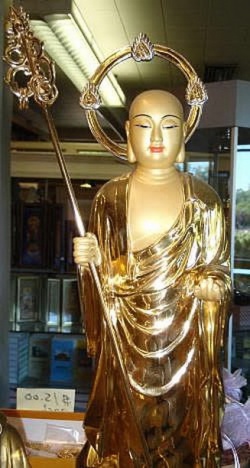Difference between revisions of "Mahāsāṃghika Vinaya"
m (Text replacement - "authority" to "authority") |
|||
| Line 1: | Line 1: | ||
[[File:Ksitigarbha-es25.jpg|thumb|250px|]] | [[File:Ksitigarbha-es25.jpg|thumb|250px|]] | ||
<poem> | <poem> | ||
| − | The [[Mahāsāṃghika | + | The [[Mahāsāṃghika Vinaya]] was translated by [[Buddhabhadra]] and [[Faxian]] in 416 CE, and is preserved in {{Wiki|Chinese}} translation ([[Taishō Tripiṭaka]] 1425). |
| − | The 6th century CE [[Indian]] [[monk]] [[Paramārtha]] wrote that 200 years after the [[parinirvāṇa]] of the [[Buddha]], much of the [[Mahāsāṃghika]] school moved north of [[Rājagṛha]], and were divided over whether the [[Mahāyāna]] teachings should be incorporated formally into their [[Tripiṭaka]]. According to this account, they split into three groups based upon the [[relative]] [[manner]] and degree to which they accepted the authority of these [[Mahāyāna]] texts. [[Paramārtha]] states that the [[Gokulika sect]] did not accept the [[Mahāyāna sūtras]] as [[buddhavacana]] ("words of the | + | The 6th century CE [[Indian]] [[monk]] [[Paramārtha]] wrote that 200 years after the [[parinirvāṇa]] of the [[Buddha]], much of the [[Mahāsāṃghika]] school moved [[north]] of [[Rājagṛha]], and were divided over whether the [[Mahāyāna]] teachings should be incorporated formally into their [[Tripiṭaka]]. |
| + | |||
| + | According to this account, they split into [[three groups]] based upon the [[relative]] [[manner]] and [[degree]] to which they accepted the authority of these [[Mahāyāna]] texts. | ||
| + | |||
| + | [[Paramārtha]] states that the [[Gokulika sect]] did not accept the [[Mahāyāna sūtras]] as [[buddhavacana]] ("[[words of the Buddha]]"), while the [[Lokottaravāda]] [[sect]] and the [[Ekavyāvahārika]] [[sect]] did accept the [[Mahāyāna sūtras]] as [[buddhavacana]]. | ||
| + | |||
| + | Also in the 6th century CE, [[Avalokitavrata]] writes of the [[Mahāsāṃghikas]] using a "[[Great Āgama Piṭaka]]," which is then associated with [[Mahāyāna sūtras]] such as the [[Prajñāparamitā]] and the [[Daśabhūmika Sūtra]]. | ||
</poem> | </poem> | ||
{{R}} | {{R}} | ||
[http://abhinawarama.com/thripitaka.html abhinawarama.com] | [http://abhinawarama.com/thripitaka.html abhinawarama.com] | ||
[[Category:Mahāsāṃghika]] | [[Category:Mahāsāṃghika]] | ||
Latest revision as of 15:19, 2 March 2015
The Mahāsāṃghika Vinaya was translated by Buddhabhadra and Faxian in 416 CE, and is preserved in Chinese translation (Taishō Tripiṭaka 1425).
The 6th century CE Indian monk Paramārtha wrote that 200 years after the parinirvāṇa of the Buddha, much of the Mahāsāṃghika school moved north of Rājagṛha, and were divided over whether the Mahāyāna teachings should be incorporated formally into their Tripiṭaka.
According to this account, they split into three groups based upon the relative manner and degree to which they accepted the authority of these Mahāyāna texts.
Paramārtha states that the Gokulika sect did not accept the Mahāyāna sūtras as buddhavacana ("words of the Buddha"), while the Lokottaravāda sect and the Ekavyāvahārika sect did accept the Mahāyāna sūtras as buddhavacana.
Also in the 6th century CE, Avalokitavrata writes of the Mahāsāṃghikas using a "Great Āgama Piṭaka," which is then associated with Mahāyāna sūtras such as the Prajñāparamitā and the Daśabhūmika Sūtra.
